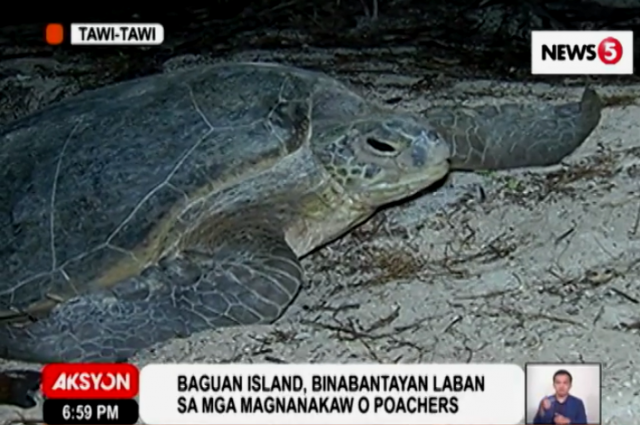
BAGUAN ISLAND, TAWI TAWI – After a six-hour bumpy ride at sea, one jaunts ashore at Baguan.
This inhabited but still pristine isle of an island, in what’s popularly known as the Turtle Islands Group, well, it’s “on that side” of Celebes Sea – actually closer to Sandakan, Malaysia than to Bongao, or Simunul, or Sitangkai.
This part of our Philippine Archipelago is a favorite breeding ground of the Green Sea Turtle.
In local generic parlance, the Pawikan.

Arriving at night, our News5 team right away encounters several Green Sea Turtles (Chelonia mydas) waddling ashore to lay their eggs on the warm sand, more than a hundred soft-shelled orbs of life from each one.
Depending on the tidal cycle, they wait for just the right time and then catch the high tide to take advantage of a limited window of opportunity to complete the arduous, exhausting yet important but delicate task that will ensure their future.
The high tide enables the turtles, tired from the reverse migration across thousands of kilometers and heavy with eggs, to “get over” obstacles on the shallow seabed that might present rocks and hindrances against their return to sea after making it to the same beach where they themselves emerged as hatchlings several decades ago, to dig the burrow and lay their eggs, and then cover the nest with sand for keeping the prospective succeeding generation from harm.

And the predators, there are many: snakes, crabs, dogs, crows, bayawak (monitor lizards). Oh yes, men of prey, too.
But there are also the other, altruistic kinds of humans – bent on faithfully running patrols, measuring and tagging them for scientific research, and protecting their nests to allow their species to thrive, instead of poaching their eggs or, worse, catching them obtusely for their prized carapace [shell] and meat.
It is said that the hatchlings don’t initially possess fully developed sex chromosomes, such that their gender is largely determined by the so-called pivotal temperature within the nest. Warmer temperatures tend to produce more females, scientists have observed, so global warming can be a factor in the fate of these turtles.
And when the “babies”, at last, pip, or break out, of their shell after a couple of months of gestation, and emerge to breathe their first waft of atmospheric air, they promptly crawl out of the sand after acclimatizing to the ambiance of this whole new world, and energetically scamper straight for the salty sea.

The same sea where uncertainty awaits. For there, beyond the rocky rough seabed lurk equally threatening prey – sharks, game fish like groupers (lapu-lapu). Only a handful out of every few thousand hatchlings are estimated to survive to adulthood, to sexual maturity, and return to this same beachhead five decades hence, to have their chance at laying their eggs, the same way their mothers did.
Amazingly, to this exact same beachhead. For such is the wondrous and wonderful life cycle of the Green Sea Turtle and other marine turtles.
Click and watch this exclusive video report below:



